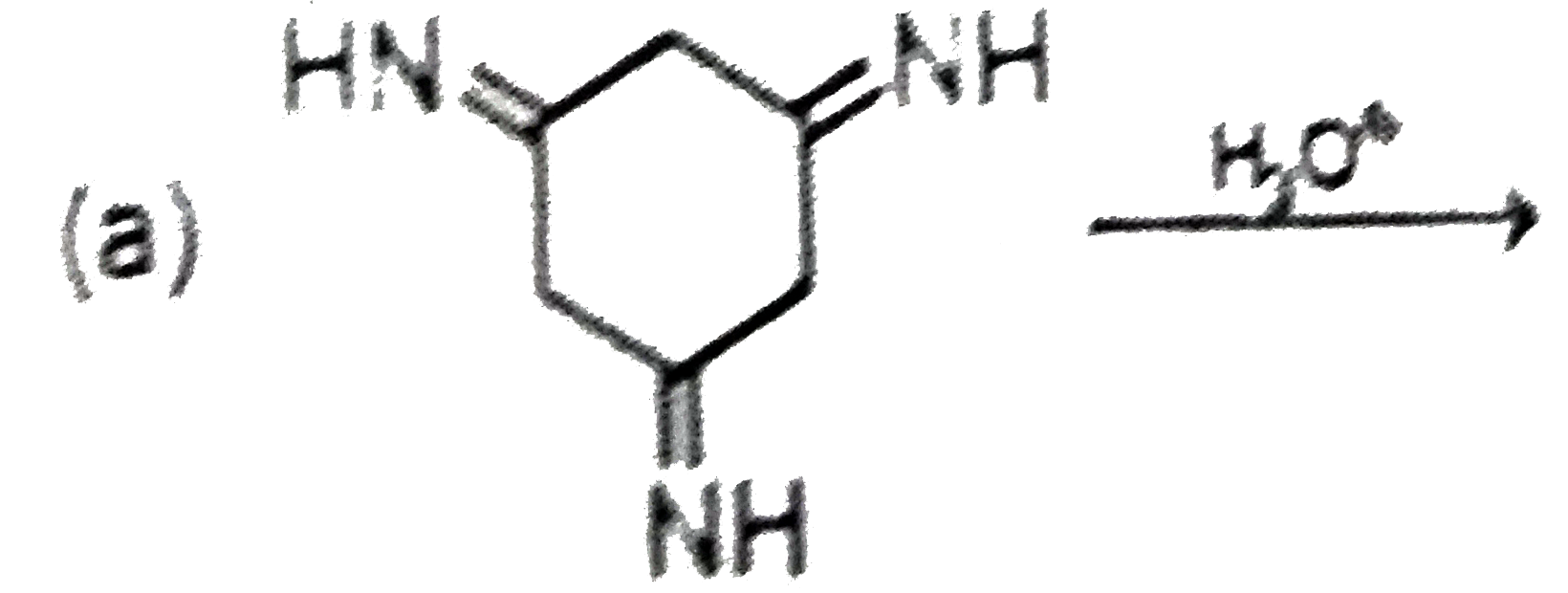Complete the following reaction :
(a) CH3CH2COCl + N3H gives (B). (B) on heating forms (C), which on hydrolysis gives (D)
To complete the reaction step by step, let's analyze the provided information and the reactions involved.
Step 1: Reaction of CH3CH2COCl with N3H
- Reactants: CH3CH2COCl (propionyl chloride) and N3H (hydrazoic acid).
- Reaction: When propionyl chloride reacts with hydrazoic acid, it undergoes a nucleophilic substitution reaction where the chlorine atom is replaced by an azide group (N3).
- Product (B): The product formed is CH3CH2C(=O)N3 (propionyl azide).
Step 2: Heating of Product B
- Reactant: B (CH3CH2C(=O)N3).
- Reaction: On heating, the azide group decomposes, releasing nitrogen gas (N2) and forming an isocyanate intermediate.
- Product (C): The product formed is CH3CH2C(=O)N (isocyanate).
Step 3: Hydrolysis of Product C
- Reactant: C (CH3CH2C(=O)N).
- Reaction: Hydrolysis of the isocyanate in the presence of water leads to the formation of an amide.
- Product (D): The final product is CH3CH2C(=O)NH2 (ethylamide) and carbon dioxide (CO2) is released.
Summary of Products
- (A) CH3CH2COCl
- (B) CH3CH2C(=O)N3
- (C) CH3CH2C(=O)N
- (D) CH3CH2C(=O)NH2
Final Answer
The complete reaction sequence is:
1. CH3CH2COCl + N3H → CH3CH2C(=O)N3 (B)
2. B (upon heating) → CH3CH2C(=O)N (C)
3. C (upon hydrolysis) → CH3CH2C(=O)NH2 (D) + CO2
- Reactants: CH3CH2COCl (propionyl chloride) and N3H (hydrazoic acid).
- Reaction: When propionyl chloride reacts with hydrazoic acid, it undergoes a nucleophilic substitution reaction where the chlorine atom is replaced by an azide group (N3).
- Product (B): The product formed is CH3CH2C(=O)N3 (propionyl azide).
- Reactant: B (CH3CH2C(=O)N3).
- Reaction: On heating, the azide group decomposes, releasing nitrogen gas (N2) and forming an isocyanate intermediate.
- Product (C): The product formed is CH3CH2C(=O)N (isocyanate).
- Reactant: C (CH3CH2C(=O)N).
- Reaction: Hydrolysis of the isocyanate in the presence of water leads to the formation of an amide.
- Product (D): The final product is CH3CH2C(=O)NH2 (ethylamide) and carbon dioxide (CO2) is released.
- (A) CH3CH2COCl
- (B) CH3CH2C(=O)N3
- (C) CH3CH2C(=O)N
- (D) CH3CH2C(=O)NH2
The complete reaction sequence is:
1. CH3CH2COCl + N3H → CH3CH2C(=O)N3 (B)
2. B (upon heating) → CH3CH2C(=O)N (C)
3. C (upon hydrolysis) → CH3CH2C(=O)NH2 (D) + CO2
Topper's Solved these Questions
- CARBOXYLIC ACIDS AND THEIR DERIVATIVESBOOK - CENGAGE CHEMISTRY ENGLISHCHAPTER - CARBOXYLIC ACIDS AND THEIR DERIVATIVESEXERCISE - Exercises (Subjective)
19 Videos
- CARBOXYLIC ACIDS AND THEIR DERIVATIVESBOOK - CENGAGE CHEMISTRY ENGLISHCHAPTER - CARBOXYLIC ACIDS AND THEIR DERIVATIVESEXERCISE - Exercises (Linked Comprehension)
34 Videos
- CARBOXYLIC ACIDS AND THEIR DERIVATIVESBOOK - CENGAGE CHEMISTRY ENGLISHCHAPTER - CARBOXYLIC ACIDS AND THEIR DERIVATIVESEXERCISE - Exercises Archives (Analytical And Descriptive)
34 Videos
- BIOMOLECULESBOOK - CENGAGE CHEMISTRY ENGLISHCHAPTER - BIOMOLECULESEXERCISE - Exercises Archives (Analytical And Descriptive)
8 Videos
- CHEMICAL KINETICSBOOK - CENGAGE CHEMISTRY ENGLISHCHAPTER - CHEMICAL KINETICSEXERCISE - Archives Subjective
23 Videos
Similar Questions
Complete the following reaction :
C6H5COCl+(CH3)2Cdto
View SolutionComplete the following : (i) C6H5COCl(CH3)2/Cd−−−−−−−→
View SolutionComplete the following
(a)
(b) Ph−O−CH=CH2H3O⊕−−−→A+B
View SolutionAcetoisonitrile on reaction with C2H5MgBr followed by hydrolysis, gives compound (A), which one further hydrolysis gives (B) and (C).
(B) and (C) are :
View SolutionBromobenzene on treatment with fuming H2SO4 gives a compound which one treatment with Cl2/AlCl3 gives (A), (A) on distillation with dil. H2SO4 gives (B). (B) on treatment with an eq. of Mg in dry ether gives (C ). (C ) on treatment with CH3CHO followed by hydrolysis gives (D). (D) on treatment with NaOl gives (E). Identify the structures of (A) to (E).
View SolutionComplete and balance the following equations:
C2H5NH2+CH3COCl→…. +……..
View SolutionComplete the following by providing (A),(B), (C) and (D)
CH3CH2CH2OHPBr3−−→(A)alc.KOH−−−−−→(B)HBr−−→(C)NH3−−→(D)
View SolutionComplete the following reaction CH3−C∣CH3=CH−CH3H2,Ni−−−→?
View SolutionConsider the following reactions :
(a) (CH3)3CH(OH)CH3conc.H2SO4−−−−−−−→
(b) (CH3)2CHCH(Br)CH3(alc.KOH)→
(c ) (CH3)2CHCH(Br)CH3((CH3)3)OΘK(⊕))→
(d) (CH3)2C∣OH−CH2−CHOΔ−−→
Which of these reaction (s) will not produce Saytzeff product ?
View Solution(a) How will you convert:
(i) Aniline into Fluorobenzene.
(ii) Benzamide into Benzylamine.
(iii) Ethanamine to N,N-Diethylethanamine.
(b) Write the structures of A and B in the following:
(i) CH3CH2CNOH−−−−−−−−−−→Partial hydrolysisANaOH+Br2−−−−−−−→B
(ii) CH3CH2Br(i)KCN−−−−−−→(ii)LiAlH4ANHO2−−−→O0CB
View Solution
